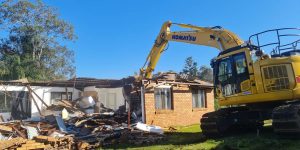Demolishing a House Step-by-Step Guide
Introduction

Demolishing a house can be a daunting task, but with the right guidance, it can be managed efficiently. This blog post aims to provide a comprehensive step-by-step guide to house demolition, ensuring you’re well-prepared for this significant undertaking.
Understanding the Basics of Demolishing a House
Before diving into the demolition process, it’s crucial to understand the meaning of demolition. Simply put, demolition is the process of safely and systematically tearing down a building. It involves various stages, from planning to the final cleanup.
Planning and Legal Requirements
The first step in any house demolition project is thorough planning. This includes:
- Researching local regulations: Different areas have different laws regarding demolition, so it’s essential to be aware of these.
- Obtaining necessary permits: Most demolition projects require a permit from local authorities. Ensure all paperwork is in order before proceeding.
Selecting a Demolition Contractor
Choosing the right demolition contractor is vital. Look for companies with a good reputation and proper licensing. A skilled contractor will guide you through the process, from obtaining permits to completing the demolition.
Cost Considerations
One common query is, “how much does demolition of a house cost?” The cost varies depending on several factors, such as the size of the house and the method of demolition used. It’s advisable to get quotes from multiple contractors to compare prices.
The Demolition Process
The demolition process generally follows these steps:
Site Preparation
The first and crucial step in the demolition process is site preparation. This stage involves several important tasks:
Hazardous Material Assessment and Removal
Before any demolition activities can commence, it’s essential to inspect the site for hazardous materials. This typically includes a thorough check for asbestos, which was commonly used in older buildings. If asbestos or other hazardous substances are found, specialized removal and disposal procedures are required to ensure the safety of workers and the environment.
Disconnecting Utilities
For safety reasons, all utilities such as gas, water, electricity, and sewage need to be properly disconnected and secured. This step is critical to prevent accidents like gas leaks, water floods, or electrical hazards during the demolition process.
Securing the Site
Erecting barriers and safety signs around the demolition area is necessary to ensure the safety of the public and workers. This also includes taking measures to control dust and debris, which can be harmful if not properly managed.
Active Demolition
Active demolition is where the building is physically taken down, and this can be done in two main ways:
Mechanical Demolition
This method is the most common and involves using heavy machinery like bulldozers, excavators, and wrecking balls. Mechanical demolition is faster and more efficient for larger structures, but it requires skilled operators to manage the heavy equipment safely and effectively.
Manual Demolition
In some cases, especially with smaller buildings or in situations where precision is required, demolition might be done manually. This involves using hand tools and smaller equipment. While more labor-intensive and time-consuming, it offers more control and is often used for partial demolitions or in densely populated areas where large machinery can’t be used.
Demolition General Cleanup
After the structure is demolished, the final stage is the cleanup process:
Debris Removal
The site will be filled with debris, including concrete, wood, metal, and other building materials. This debris must be removed from the site systematically. Depending on local regulations and the nature of the materials, debris may be taken to a landfill, recycling center, or specialized disposal facility.
Site Grading and Preparation for Next Use
Once the debris is cleared, the site is often graded and prepared for its next use, whether it be construction, landscaping, or left as an open space. Proper grading ensures that the site is safe, stable, and meets any specific requirements for future projects.
Environmental Cleanup
In addition to physical debris removal, environmental cleanup may be necessary, especially if the demolition involved hazardous materials. This step ensures that the site does not pose any environmental or health risks going forward.
How Long Does House Demolition Take?
How long does house demolition take depends on the size of the structure and the method used. Typically, it can take anywhere from a few days to several weeks.
Key Steps in Detail
Let’s break down some key steps in more detail:
Choosing a Demolition Method
There are primarily two methods of demolition:
- Mechanical demolition: Involves heavy machinery, like bulldozers and excavators. It’s faster but less environmentally friendly.
- Deconstruction: A more labor-intensive process where parts of the house are dismantled piece by piece, allowing for more recycling.
Considerations for Each Method:
Mechanical Demolition
Mechanical demolition is the process of tearing down a building using heavy machinery such as bulldozers, excavators, and wrecking balls. Some Considerations are:
- Faster process.
- Generally more cost-effective.
- Less environmentally friendly.
Deconstruction
Process of carefully dismantling a building piece by piece, with the primary goal of salvaging as much of the materials as possible for reuse and recycling. These are some considerations for deconstruction:
- Time-consuming.
- More expensive.
- Better for recycling and reducing waste.
Working With Your Demolition Contractor
A good demolition contractor will walk you through the process, ensuring you understand each step. They should also handle:
- Obtaining permits.
- Ensuring safety standards are met.
- Coordinating the demolition and cleanup process.
Post-Demolition Steps
After the demolition, the demolition general cleanup is crucial. This involves removing debris and ensuring the site is safe and ready for its next use.
Benefits of Hiring a Professional Demolition Team

Opting for a professional demolition team brings numerous advantages, particularly when tackling a project as significant as house demolition. Here’s why hiring experts is a wise decision:
Expertise and Experience
Professional demolition teams possess the necessary skills and knowledge to handle various types of demolition projects. They understand the intricacies of the process and can anticipate and manage potential challenges effectively.
Safety
Demolition can be dangerous. Professionals are trained in safety protocols to ensure the well-being of everyone involved and the protection of adjacent properties. They are adept at mitigating risks associated with demolition, like structural collapses or hazardous material exposure.
Efficiency
Professional teams are equipped with the right tools and machinery to carry out the demolition swiftly and efficiently. This means that the project is completed faster, allowing you to move forward with your plans sooner.
Legal Compliance
Navigating the legalities of demolition, such as permits and regulations, can be complex. Professional teams are familiar with these requirements and ensure that your project complies with all local laws and guidelines, thus avoiding potential legal issues.
Waste Management and Environmental Responsibility
A significant aspect of demolition is dealing with the aftermath – the debris and waste materials. Professional demolition teams often have systems in place for efficient waste removal, recycling, and disposal, ensuring an environmentally responsible approach.
Cost-Effectiveness
While it might seem counterintuitive, hiring a professional team can be cost-effective in the long run. They can prevent costly mistakes, reduce the risk of damage to nearby structures, and offer a comprehensive service package that includes both demolition and cleanup.
Stress Reduction
Managing a demolition project on your own can be stressful. Hiring professionals relieves you of the burden of planning, executing, and monitoring the demolition, allowing you to focus on your future plans for the site.
Conclusion
In summary, the process of demolishing a house requires careful consideration of various factors, including choosing the right demolition method, understanding the costs involved, ensuring legal compliance, and prioritizing safety and environmental responsibility. By following a structured, step-by-step guide and being aware of the potential challenges and solutions, homeowners can navigate the demolition process more effectively, making way for new developments and opportunities.
If you’re looking for a reliable and experienced partner to guide you through your house demolition project, our company, Rapid Demolition, is here to help. With our team of skilled professionals, state-of-the-art equipment, and commitment to safety and efficiency, we offer a seamless and hassle-free demolition experience. At Rapid Demolition, we understand the complexities of the demolition process. We are dedicated to providing our clients with top-notch service, ensuring that every aspect of the project is managed with the utmost care and professionalism. Whether it’s a small residential structure or a larger commercial building, we have the expertise to handle it all. Reach out to us to discuss your demolition needs and discover how we can assist you in making your project a success.
